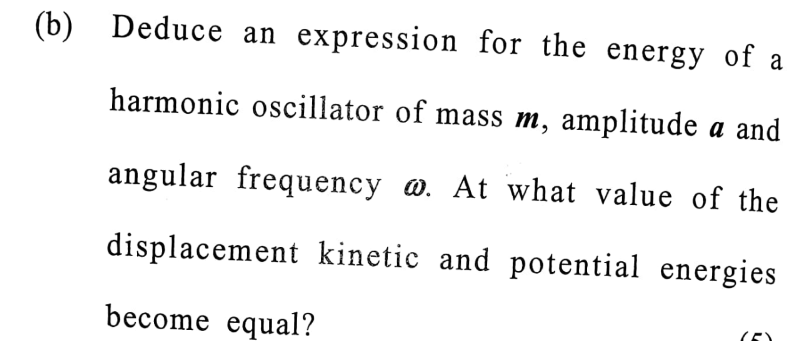Deduce an expression for the energy of a harmonic oscillator of mass m, amplitude a and angular frequency ω. At what value of the displacement do the kinetic and potential energies... Deduce an expression for the energy of a harmonic oscillator of mass m, amplitude a and angular frequency ω. At what value of the displacement do the kinetic and potential energies become equal?

Understand the Problem
The question is asking for the derivation of an expression for the energy of a harmonic oscillator with given parameters. It also seeks to identify the displacement value at which kinetic and potential energies are equal.
Answer
The energy of the harmonic oscillator is $E = \frac{1}{2} m \omega^2 a^2$ and kinetic equals potential energy at $x = \frac{a}{\sqrt{2}}$.
Answer for screen readers
The expression for the energy of a harmonic oscillator is
$$ E = \frac{1}{2} m \omega^2 a^2 $$
The displacement at which kinetic and potential energies are equal is
$$ x = \frac{a}{\sqrt{2}} $$.
Steps to Solve
- Expression for Potential Energy (PE)
The potential energy of a harmonic oscillator is given by the formula:
$$ PE = \frac{1}{2} k x^2 $$
where $k$ is the spring constant and $x$ is the displacement.
Given that the spring constant is related to the angular frequency by the formula $ k = m\omega^2 $, we can substitute this into the potential energy formula:
$$ PE = \frac{1}{2} m \omega^2 x^2 $$
- Expression for Kinetic Energy (KE)
The kinetic energy of a harmonic oscillator is given by:
$$ KE = \frac{1}{2} m v^2 $$
Here, $v$ can be expressed in terms of displacement and angular frequency as:
$$ v = \frac{dx}{dt} = -a \omega \sin(\omega t) $$
Substituting for velocity in the kinetic energy formula leads us to:
$$ KE = \frac{1}{2} m (a \omega \cos(\omega t))^2 = \frac{1}{2} m a^2 \omega^2 \cos^2(\omega t) $$
- Total Mechanical Energy (E)
The total mechanical energy of the harmonic oscillator, which is constant, is given by the potential energy at maximum displacement (amplitude $a$):
$$ E = \frac{1}{2} k a^2 = \frac{1}{2} m \omega^2 a^2 $$
- Setting Kinetic Energy Equal to Potential Energy
To find the displacement $x$ where kinetic energy equals potential energy, set $KE = PE$:
$$ \frac{1}{2} m a^2 \omega^2 \cos^2(\omega t) = \frac{1}{2} m \omega^2 x^2 $$
- Solving for Displacement
Dividing both sides by $\frac{1}{2} m \omega^2$ gives:
$$ a^2 \cos^2(\omega t) = x^2 $$
We derive that:
$$ x = a \cos(\omega t) $$
The condition for $KE = PE$ occurs when:
$$ x = \frac{a}{\sqrt{2}} $$
The expression for the energy of a harmonic oscillator is
$$ E = \frac{1}{2} m \omega^2 a^2 $$
The displacement at which kinetic and potential energies are equal is
$$ x = \frac{a}{\sqrt{2}} $$.
More Information
The total mechanical energy of a harmonic oscillator remains constant as it oscillates between kinetic and potential energy. The energy expression is derived from both types of energy involved in the system, and the displacement value indicates a specific point in the oscillation where kinetic and potential energies are balanced.
Tips
- Failing to correctly relate the spring constant $k$ with the mass and angular frequency.
- Mixing up the maximum velocity and maximum displacement; it's crucial to relate them through the correct harmonic motion equations.
- Overlooking the factor of $\frac{1}{\sqrt{2}}$ when solving for the displacement where $KE = PE$.
AI-generated content may contain errors. Please verify critical information